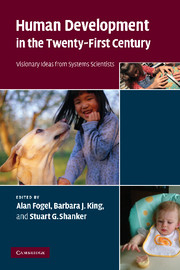Book contents
- Frontmatter
- Contents
- List of contributors
- Introduction: Why a dynamic systems approach to fostering human development?
- Part I Dynamic relationships between genetics and environments
- Part II The dynamic system of the child in the family
- Part III The dynamic system of the child in social and physical environment
- 10 The tempest: anthropology and human development
- 11 An anthropology of human development: what difference does it make?
- 12 The social child
- 13 Learning about human development from a study of educational failure
- 14 Dynamic views of education
- 15 Embodied communication in non-human animals
- 16 Children in the living world: why animals matter for children's development
- Part IV Dynamic systems approaches to mental health
- Part V Conclusions and outlook
- Index
10 - The tempest: anthropology and human development
Published online by Cambridge University Press: 22 September 2009
- Frontmatter
- Contents
- List of contributors
- Introduction: Why a dynamic systems approach to fostering human development?
- Part I Dynamic relationships between genetics and environments
- Part II The dynamic system of the child in the family
- Part III The dynamic system of the child in social and physical environment
- 10 The tempest: anthropology and human development
- 11 An anthropology of human development: what difference does it make?
- 12 The social child
- 13 Learning about human development from a study of educational failure
- 14 Dynamic views of education
- 15 Embodied communication in non-human animals
- 16 Children in the living world: why animals matter for children's development
- Part IV Dynamic systems approaches to mental health
- Part V Conclusions and outlook
- Index
Summary
Humans make their own history, but they do not make it as they please; they do not make it under self-selected circumstances, but under circumstances existing already, given and transmitted from the past.
The truth of this statement is obvious to anyone who reflects on their own childhood, for we do not select for ourselves where we were born nor who our parents are. We come into a world already given to us, and we have to find our place within it. Our developmental possibilities are constrained by the world as we find it. Equally, however, our developmental possibilities, as they take shape, create new worlds for others, new circumstances that will already exist, given and transmitted from the past, for other people. If the world is given to us, then important aspects of it become, as we develop, what we in turn give to others. Anthropologists who have spent time studying people whose experience of the world is markedly different from their own necessarily understand these gifts in a particular way. I want to explain how I understand these gifts through a story about my time living among the Piro people of the Bajo Urubamba River in Peruvian Amazonia, and what they have taught me.
I want to explain how I understand these gifts in the form of a story because this is what Piro people insistently taught me to do.
- Type
- Chapter
- Information
- Human Development in the Twenty-First CenturyVisionary Ideas from Systems Scientists, pp. 91 - 103Publisher: Cambridge University PressPrint publication year: 2007

